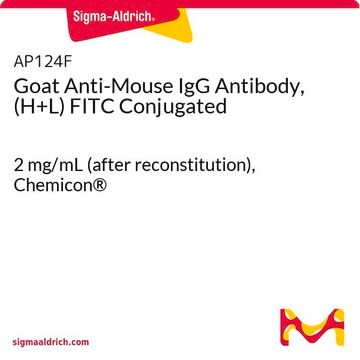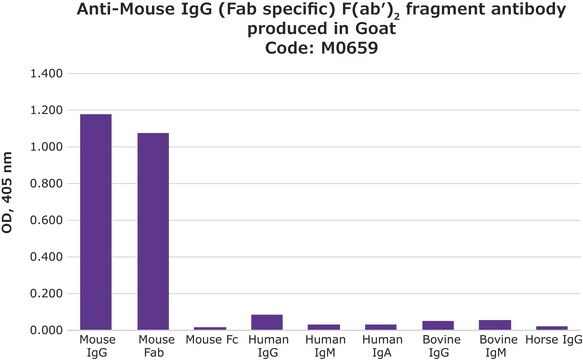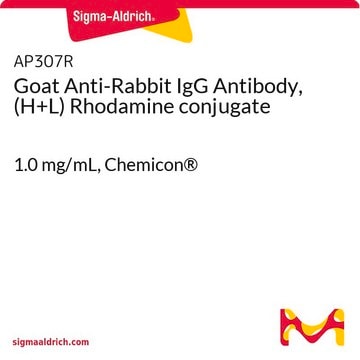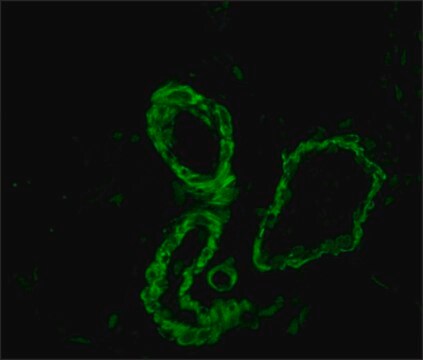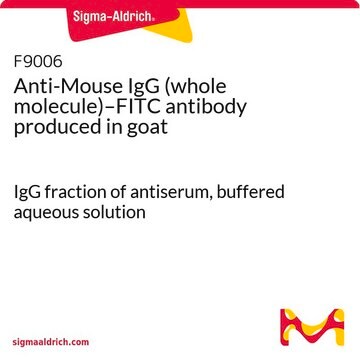F8521
Anti-Mouse IgG (Fab specific) F(ab′)2 fragment–FITC antibody produced in goat
affinity isolated antibody, buffered aqueous solution
Scegli un formato
Scegli un formato
About This Item
Prodotti consigliati
Origine biologica
goat
Coniugato
FITC conjugate
Forma dell’anticorpo
affinity isolated antibody
Tipo di anticorpo
secondary antibodies
Clone
polyclonal
Stato
buffered aqueous solution
Condizioni di stoccaggio
protect from light
tecniche
immunohistochemistry (formalin-fixed, paraffin-embedded sections): 1:320
Temperatura di conservazione
−20°C
modifica post-traduzionali bersaglio
unmodified
Cerchi prodotti simili? Visita Guida al confronto tra prodotti
Categorie correlate
Descrizione generale
Specificità
Useful when trying to avoid background staining due to the presence of Fc receptors. Anti-Mouse IgG (Fab specific) F(ab′)2 fragment-FITC antibody recognizes Fab fragment of mouse IgG. No cross reaction is observed with the Fc fragment of mouse IgG. No reactivity is observed with human, horse or bovine serum. The antibody is purified by affinity isolation and conjugated with FITC in an alkaline reaction.
Immunogeno
Applicazioni
- flow cytometry for fluorescence-activated cell sorting (FACS) analysis
- immunofluorescence and confocal microscopy
- immunofluorescent HSP72 detection/immunocytochemistry experiments
Azioni biochim/fisiol
Altre note
Stato fisico
Nota sulla preparazione
Esclusione di responsabilità
Non trovi il prodotto giusto?
Prova il nostro Motore di ricerca dei prodotti.
Codice della classe di stoccaggio
10 - Combustible liquids
Classe di pericolosità dell'acqua (WGK)
nwg
Punto d’infiammabilità (°F)
Not applicable
Punto d’infiammabilità (°C)
Not applicable
Dispositivi di protezione individuale
Eyeshields, Gloves, multi-purpose combination respirator cartridge (US)
Scegli una delle versioni più recenti:
Certificati d'analisi (COA)
Non trovi la versione di tuo interesse?
Se hai bisogno di una versione specifica, puoi cercare il certificato tramite il numero di lotto.
Possiedi già questo prodotto?
I documenti relativi ai prodotti acquistati recentemente sono disponibili nell’Archivio dei documenti.
I clienti hanno visto anche
Filtri attivi
Il team dei nostri ricercatori vanta grande esperienza in tutte le aree della ricerca quali Life Science, scienza dei materiali, sintesi chimica, cromatografia, discipline analitiche, ecc..
Contatta l'Assistenza Tecnica.